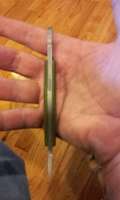Karambit
| Karambit | |
|---|---|
|
A traditional karambit | |
| Type | Concealed blade/farming tool |
| Place of origin | Indonesia |
| Specifications | |
| Blade type | Single or double edged, crescent curve |
| Hilt type | Water buffalo horn, wooden, ivory |
| Scabbard/sheath | Water buffalo horn, wooden |
The karambit (Minangkabau language: kurambik or karambiak) is a small Southeast Asian curved knife resembling a claw. Known as kerambit in its native Indonesian and Malay, it is called karambit in the Philippines and in most Western countries.[1]
Origin

The karambit is believed to have originated among the Minangkabau people of West Sumatra[2] where, according to folklore, it was inspired by the claws of big cats. As with most weapons of the region, it was originally an agricultural implement designed to rake roots, gather threshing and plant rice. As it was weaponised, the blade became more curved to maximise cutting potential. Through Indonesia's trade network and close contact with neighbouring countries, the karambit was eventually dispersed through what are now Cambodia, Laos, Malaysia, Myanmar, Thailand and the Philippines.[3][4]
Culturally the karambit was a subject of condescension in Java because of its history as a weapon of the agrarian peasantry, as opposed to the kesatria (warrior class) who were trained in the keraton or palace. European accounts tell that soldiers in Indonesia were armed with a kris at their waist or back and a spear in their hands, while the kerambit was used as a last resort when the fighter's other weapons were lost in battle. Nevertheless, it was popular among women who would tie the weapon into their hair to be used in self-defense. Even today, silat practitioners regard it as a feminine weapon. The renowned Bugis warriors of Sulawesi were famous for their embrace of the kerambit. Today it is one of the main weapons of silat and is commonly used in Filipino martial arts as well.[5]
Superficially the kerambit resembles the jambiyah but there is no connection. The jambiyah was always designed as a weapon and serves as a status marker, often made by skilled artisans and jewelers using precious stones and metals, whereas the kerambit was and still remains an unadorned, modest farmer's implement and useful utility knife.[5]
Technique



The karambit is held with the blade pointing downward from the bottom of the fist, usually curving forwards however occasionally backwards. While it is primarily used in a slashing or hooking motion, karambit with a finger ring are also used in a punching motion hitting the opponent with the finger ring. Some karambit are designed to be used in a hammering motion. This flexibility of striking methods is what makes it so useful in self-defense situations. The finger guard makes it difficult to disarm and allows the knife to be maneuvered in the fingers without losing one's grip.[5]
The short Filipino karambit has found some favor in the West because such proponents allege the biomechanics of the weapon allow for more powerful cutting strokes and painful "ripping" wounds, and because its usability is hypothesized as more intuitive, though there continues to be debate about this matter.[5]
Variations
There are many regional variants of kerambit. The length of the blade, for example, could vary from one village or blacksmith to another. Some have no finger guard and some feature two blades, one on each side of the handle. Traditional types include:
- Kuku Bima: Bima's claw from West Java
- Kuku Hanuman: Hanuman's claw from West Java
- Kuku Machan: tiger's claw, endemic to Sumatra, Central Java and Madura
- Kerambit Sumbawa: larger, sturdier kerambit made specially for battle. From the Sumba Islands
- Kerambit Lombok: larger, sturdier kerambit made specially for battle. From Lombok
- Lawi Ayam: chicken's claw, created by the Minang community
Additionally, modern kerambit may have spikes or spurs on the front or rear ricasso, which may be intended for gripping clothing or horse tack, tearing flesh or for injecting a poison, such as the upas.[6]
Modern forms
.jpg)
.jpg)
The modern Western interpretation of the karambit is far removed from the original agricultural tool. They may have folding blades, are finished to a high standard, made from expensive materials as opposed to being rudimentary and makeshift and are generally larger to accommodate larger hands.[7]
The West has recently found the karambit to be useful for self-defense. Most of those produced in the West for use as weapons are based on the small Filipino variety, which features a short blade and index finger ring. Both fixed blade (generally double-edged) and folding (generally single-edged) karambit are produced by a number of makers, including Elemental Knives, Warren Thomas,[8] Mantis Knives,[9] Emerson Knives,[10] Strider Knives,[11] Spyderco,[8] Cold Steel,[12] Craig Camerer, United Cutlery, Rich Derespina,[13] Cutters Knife and Tool,[14] 5.11 Tactical,[15] Mike Snody, Quartermaster Knives, Fox Cutlery and Karambitmaker studio[16]
In popular culture
- A karambit is included in the crest of the Royal Malaysian Police.
- Karambits can be obtained in the video game Counter-Strike: Global Offensive and are typically the second rarest and most expensive knives in the game.
- Javanese playwright Nadiputra titled one of his three plays Awang Karambit.[17]
- Sam Fisher (portrayed by Canadian actor Eric Johnson) in Splinter Cell Blacklist is armed with a modern karambit.[18]
- Karambits are the main weapons of The Assassin (portrayed by Indonesian actor, Cecep Arif Rahman) in The Raid 2.
- Karambits can be obtained in the video game Crossfire as fast, but short-ranged, melee weapons.
See also
References
- ↑ Farrer, D. S. (5 June 2009). Shadows of the Prophet: Martial Arts and Sufi Mysticism. Springer Science & Business Media. p. 91. ISBN 978-1-4020-9356-2.
- ↑ Agus Mulyana (2010). "KERAMBIT: Senjata Genggam Khas Minangkabau". Sumedang Online. Retrieved 2014-10-09.
- ↑ Proyek Pembinaan Permuseuman Jakarta (Indonesia). Koleksi pilihan museum-museum negeri propinsi. Proyek Pembinaan Permuseuman Jakarta: 1989. 65 pages
- ↑ D. Christo (2014). "Karambit FAQ". Karambit.com.
- 1 2 3 4 Tarani, Steve (2002). Karambit: Exotic Weapon of the Indonesian Archipelago. Unique Publications. pp. 15–22. ISBN 978-0-86568-206-1.
- ↑ Sheikh Shamsuddin. The Malay art of self-defense: silat seni gayong. North Atlantic Books, 2005 ISBN 1-55643-562-2, ISBN 978-1-55643-562-1. 247 pages. pp234
- ↑ Emerson, Ernest (February 2004). "The Battle Blade". Black Belt. Los Angeles, California: Active Interest Media, Inc. 42 (2): 80–85. ISSN 0277-3066. Retrieved 3 March 2015.
- 1 2 Torres, J (November 2004). "Essential Gear". Black Belt. Active Interest Media, Inc. 42 (11): 54. ISSN 0277-3066.
- ↑ "Mantis Knives".
- ↑ Young, Robert (April 2003). "Emerson Karambit Knife". Black Belt. Active Interest Media, Inc. 41 (4): 136. ISSN 0277-3066.
- ↑ "Model HS Karambit". Strider Knives Inc. Retrieved 2008-09-15.
- ↑ "Steel Tiger". Cold Steel. Retrieved 2008-09-15.
- ↑ "Custom Knife Gallery". Derespina Knives. Retrieved 2008-09-15.
- ↑ "Bengal folding Karambit". Cutters Knife and Tool, Inc. Retrieved 2008-09-15.
- ↑ "5.11 Tactical Knives". 5.11 Tactical. Retrieved 2015-03-03.
- ↑ "Karambits". Fox Cutlery.
- ↑ Purushothaman, Venka (2002). Narratives: Notes on a Cultural Journey : Cultural Medallion Recipients, 1979-2001. National Arts Council. pp. 136, 140. ISBN 978-981-04-6737-1.
- ↑ "Sam Fisher's Karambit". Unfinished Man. Retrieved 16 September 2014.
External links
- Karambit.com - Articles, history and legalities about the karambit